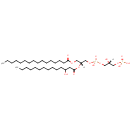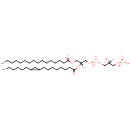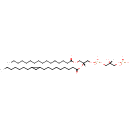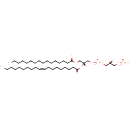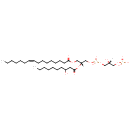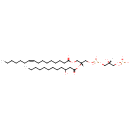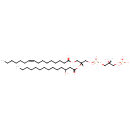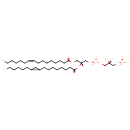
Search Results for compounds
Searching compounds for
returned 4373 results.
Displaying compounds 2611 - 2620 of
4373 in total
PGP(16:0/14:0(3-OH)) (PAMDB006601)
IUPAC:
[(2R)-3-({[(2R)-3-(hexadecanoyloxy)-2-[(3-hydroxytetradecanoyl)oxy]propoxy](hydroxy)phosphoryl}oxy)-2-hydroxypropoxy]phosphonic acid
CAS: Not Available
Description: PGP(16:0/14:0(3-OH)) belongs to the class of glycerophosphoglycerophosphates, also called phosphatidylglycerophosphates (PGPs). These lipids contain a common glycerophosphate skeleton linked to at least one fatty acyl chain and a glycero-3-phosphate moiety. As is the case with diacylglycerols, phosphatidylglycerophosphates can have many different combinations of fatty acids of varying lengths and saturation attached to the C-1 and C-2 positions. PGP(16:0/14:0(3-OH)), in particular, consists of one hexadecanoyl chain to the C-1 atom, and one 3-hydroxytetradecanoyl to the C-2 atom. In Pseudomonas aeruginosa, PGPs can be found in the cytoplasmic membrane. The are synthesized by the addition of glycerol 3-phosphate to a CDP-diacylglycerol. In turn, PGPs are dephosphorylated to Phosphatidylglycerols (PGs) by the enzyme Phosphatidylglycerophosphatase.
PGP(16:0/17:0cycw7c) (PAMDB006602)
IUPAC:
[(2R)-3-({[(2R)-3-(hexadecanoyloxy)-2-{[8-(2-hexylcyclopropyl)octanoyl]oxy}propoxy](hydroxy)phosphoryl}oxy)-2-hydroxypropoxy]phosphonic acid
CAS: Not Available
Description: PGP(16:0/17:0cycw7c) belongs to the class of glycerophosphoglycerophosphates, also called phosphatidylglycerophosphates (PGPs). These lipids contain a common glycerophosphate skeleton linked to at least one fatty acyl chain and a glycero-3-phosphate moiety. As is the case with diacylglycerols, phosphatidylglycerophosphates can have many different combinations of fatty acids of varying lengths and saturation attached to the C-1 and C-2 positions. PGP(16:0/17:0cycw7c), in particular, consists of one hexadecanoyl chain to the C-1 atom, and one heptadec-9-10-cyclo-anoyl to the C-2 atom. In Pseudomonas aeruginosa, PGPs can be found in the cytoplasmic membrane. The are synthesized by the addition of glycerol 3-phosphate to a CDP-diacylglycerol. In turn, PGPs are dephosphorylated to Phosphatidylglycerols (PGs) by the enzyme Phosphatidylglycerophosphatase.
PGP(16:0/19:0cycw8c) (PAMDB006604)
IUPAC:
[(2R)-3-({[(2R)-2-{[9-(2-heptylcyclopropyl)nonanoyl]oxy}-3-(hexadecanoyloxy)propoxy](hydroxy)phosphoryl}oxy)-2-hydroxypropoxy]phosphonic acid
CAS: Not Available
Description: PGP(16:0/19:0cycw8c) belongs to the class of glycerophosphoglycerophosphates, also called phosphatidylglycerophosphates (PGPs). These lipids contain a common glycerophosphate skeleton linked to at least one fatty acyl chain and a glycero-3-phosphate moiety. As is the case with diacylglycerols, phosphatidylglycerophosphates can have many different combinations of fatty acids of varying lengths and saturation attached to the C-1 and C-2 positions. PGP(16:0/19:0cycw8c), in particular, consists of one hexadecanoyl chain to the C-1 atom, and one 9-(2-heptylcyclopropyl)nonanoyl to the C-2 atom. In Pseudomonas aeruginosa, PGPs can be found in the cytoplasmic membrane. The are synthesized by the addition of glycerol 3-phosphate to a CDP-diacylglycerol. In turn, PGPs are dephosphorylated to Phosphatidylglycerols (PGs) by the enzyme Phosphatidylglycerophosphatase.
PGP(16:0/19:1(9Z)) (PAMDB006605)
IUPAC:
[(2R)-3-({[(2R)-3-(hexadecanoyloxy)-2-[(9Z)-nonadec-9-enoyloxy]propoxy](hydroxy)phosphoryl}oxy)-2-hydroxypropoxy]phosphonic acid
CAS: Not Available
Description: PGP(16:0/19:1(9Z)) belongs to the class of glycerophosphoglycerophosphates, also called phosphatidylglycerophosphates (PGPs). These lipids contain a common glycerophosphate skeleton linked to at least one fatty acyl chain and a glycero-3-phosphate moiety. As is the case with diacylglycerols, phosphatidylglycerophosphates can have many different combinations of fatty acids of varying lengths and saturation attached to the C-1 and C-2 positions. PGP(16:0/19:1(9Z)), in particular, consists of one hexadecanoyl chain to the C-1 atom, and one 9Z-nonadecenoyl to the C-2 atom. In Pseudomonas aeruginosa, PGPs can be found in the cytoplasmic membrane. The are synthesized by the addition of glycerol 3-phosphate to a CDP-diacylglycerol. In turn, PGPs are dephosphorylated to Phosphatidylglycerols (PGs) by the enzyme Phosphatidylglycerophosphatase.
PGP(16:0/19:iso) (PAMDB006606)
IUPAC:
Not Available
CAS: Not Available
Description: PGP(16:0/19:iso) belongs to the class of glycerophosphoglycerophosphates, also called phosphatidylglycerophosphates (PGPs). These lipids contain a common glycerophosphate skeleton linked to at least one fatty acyl chain and a glycero-3-phosphate moiety. As is the case with diacylglycerols, phosphatidylglycerophosphates can have many different combinations of fatty acids of varying lengths and saturation attached to the C-1 and C-2 positions. PGP(16:0/19:iso), in particular, consists of one hexadecanoyl chain to the C-1 atom, and one 17-methylocatdecanoyl to the C-2 atom. In Pseudomonas aeruginosa, PGPs can be found in the cytoplasmic membrane. The are synthesized by the addition of glycerol 3-phosphate to a CDP-diacylglycerol. In turn, PGPs are dephosphorylated to Phosphatidylglycerols (PGs) by the enzyme Phosphatidylglycerophosphatase.
PGP(16:1(9Z)/10:0(3-OH)) (PAMDB006607)
IUPAC:
[(2R)-3-({[(2R)-3-[(9Z)-hexadec-9-enoyloxy]-2-[(3-hydroxydecanoyl)oxy]propoxy](hydroxy)phosphoryl}oxy)-2-hydroxypropoxy]phosphonic acid
CAS: Not Available
Description: PGP(16:1(9Z)/10:0(3-OH)) belongs to the class of glycerophosphoglycerophosphates, also called phosphatidylglycerophosphates (PGPs). These lipids contain a common glycerophosphate skeleton linked to at least one fatty acyl chain and a glycero-3-phosphate moiety. As is the case with diacylglycerols, phosphatidylglycerophosphates can have many different combinations of fatty acids of varying lengths and saturation attached to the C-1 and C-2 positions. PGP(16:1(9Z)/10:0(3-OH)), in particular, consists of one 9Z-hexadecenoyl chain to the C-1 atom, and one 3-hydroxydecanoyl to the C-2 atom. In Pseudomonas aeruginosa, PGPs can be found in the cytoplasmic membrane. The are synthesized by the addition of glycerol 3-phosphate to a CDP-diacylglycerol. In turn, PGPs are dephosphorylated to Phosphatidylglycerols (PGs) by the enzyme Phosphatidylglycerophosphatase.
PGP(16:1(9Z)/12:0(3-OH)) (PAMDB006608)
IUPAC:
[(2R)-3-({[(2R)-3-[(9Z)-hexadec-9-enoyloxy]-2-[(3-hydroxydodecanoyl)oxy]propoxy](hydroxy)phosphoryl}oxy)-2-hydroxypropoxy]phosphonic acid
CAS: Not Available
Description: PGP(16:1(9Z)/12:0(3-OH)) belongs to the class of glycerophosphoglycerophosphates, also called phosphatidylglycerophosphates (PGPs). These lipids contain a common glycerophosphate skeleton linked to at least one fatty acyl chain and a glycero-3-phosphate moiety. As is the case with diacylglycerols, phosphatidylglycerophosphates can have many different combinations of fatty acids of varying lengths and saturation attached to the C-1 and C-2 positions. PGP(16:1(9Z)/12:0(3-OH)), in particular, consists of one 9Z-hexadecenoyl chain to the C-1 atom, and one 3-hydroxydodecanoyl to the C-2 atom. In Pseudomonas aeruginosa, PGPs can be found in the cytoplasmic membrane. The are synthesized by the addition of glycerol 3-phosphate to a CDP-diacylglycerol. In turn, PGPs are dephosphorylated to Phosphatidylglycerols (PGs) by the enzyme Phosphatidylglycerophosphatase.
PGP(16:1(9Z)/14:0(3-OH)) (PAMDB006609)
IUPAC:
[(2R)-3-({[(2R)-3-[(9Z)-hexadec-9-enoyloxy]-2-[(3-hydroxytetradecanoyl)oxy]propoxy](hydroxy)phosphoryl}oxy)-2-hydroxypropoxy]phosphonic acid
CAS: Not Available
Description: PGP(16:1(9Z)/14:0(3-OH)) belongs to the class of glycerophosphoglycerophosphates, also called phosphatidylglycerophosphates (PGPs). These lipids contain a common glycerophosphate skeleton linked to at least one fatty acyl chain and a glycero-3-phosphate moiety. As is the case with diacylglycerols, phosphatidylglycerophosphates can have many different combinations of fatty acids of varying lengths and saturation attached to the C-1 and C-2 positions. PGP(16:1(9Z)/14:0(3-OH)), in particular, consists of one 9Z-hexadecenoyl chain to the C-1 atom, and one 3-hydroxytetradecanoyl to the C-2 atom. In Pseudomonas aeruginosa, PGPs can be found in the cytoplasmic membrane. The are synthesized by the addition of glycerol 3-phosphate to a CDP-diacylglycerol. In turn, PGPs are dephosphorylated to Phosphatidylglycerols (PGs) by the enzyme Phosphatidylglycerophosphatase.
PGP(16:1(9Z)/17:0cycw7c) (PAMDB006610)
IUPAC:
[(2R)-3-({[(2R)-3-[(9Z)-hexadec-9-enoyloxy]-2-{[8-(2-hexylcyclopropyl)octanoyl]oxy}propoxy](hydroxy)phosphoryl}oxy)-2-hydroxypropoxy]phosphonic acid
CAS: Not Available
Description: PGP(16:1(9Z)/17:0cycw7c) belongs to the class of glycerophosphoglycerophosphates, also called phosphatidylglycerophosphates (PGPs). These lipids contain a common glycerophosphate skeleton linked to at least one fatty acyl chain and a glycero-3-phosphate moiety. As is the case with diacylglycerols, phosphatidylglycerophosphates can have many different combinations of fatty acids of varying lengths and saturation attached to the C-1 and C-2 positions. PGP(16:1(9Z)/17:0cycw7c), in particular, consists of one 9Z-hexadecenoyl chain to the C-1 atom, and one heptadec-9-10-cyclo-anoyl to the C-2 atom. In Pseudomonas aeruginosa, PGPs can be found in the cytoplasmic membrane. The are synthesized by the addition of glycerol 3-phosphate to a CDP-diacylglycerol. In turn, PGPs are dephosphorylated to Phosphatidylglycerols (PGs) by the enzyme Phosphatidylglycerophosphatase.
PGP(16:1(9Z)/19:0cycv8c) (PAMDB006611)
IUPAC:
[(2R)-3-({[(2R)-3-[(9Z)-hexadec-9-enoyloxy]-2-{[10-(2-hexylcyclopropyl)decanoyl]oxy}propoxy](hydroxy)phosphoryl}oxy)-2-hydroxypropoxy]phosphonic acid
CAS: Not Available
Description: PGP(16:1(9Z)/19:0cycv8c) belongs to the class of glycerophosphoglycerophosphates, also called phosphatidylglycerophosphates (PGPs). These lipids contain a common glycerophosphate skeleton linked to at least one fatty acyl chain and a glycero-3-phosphate moiety. As is the case with diacylglycerols, phosphatidylglycerophosphates can have many different combinations of fatty acids of varying lengths and saturation attached to the C-1 and C-2 positions. PGP(16:1(9Z)/19:0cycv8c), in particular, consists of one 9Z-hexadecenoyl chain to the C-1 atom, and one heptadec-11-12-cyclo-anoyl to the C-2 atom. In Pseudomonas aeruginosa, PGPs can be found in the cytoplasmic membrane. The are synthesized by the addition of glycerol 3-phosphate to a CDP-diacylglycerol. In turn, PGPs are dephosphorylated to Phosphatidylglycerols (PGs) by the enzyme Phosphatidylglycerophosphatase.
